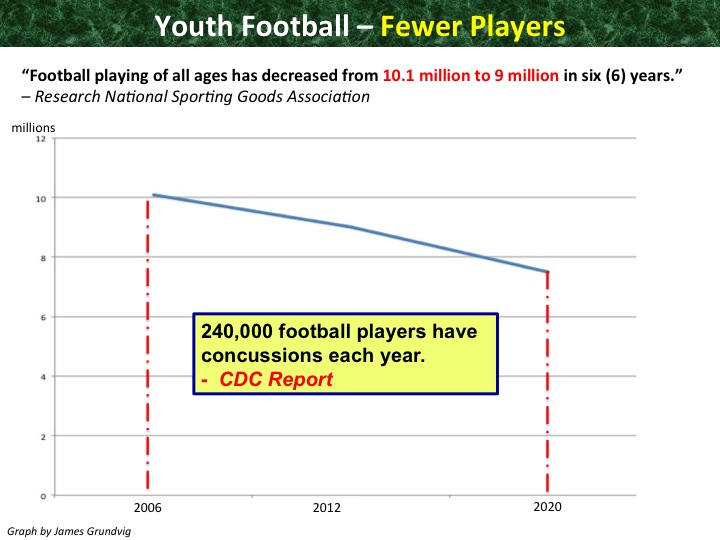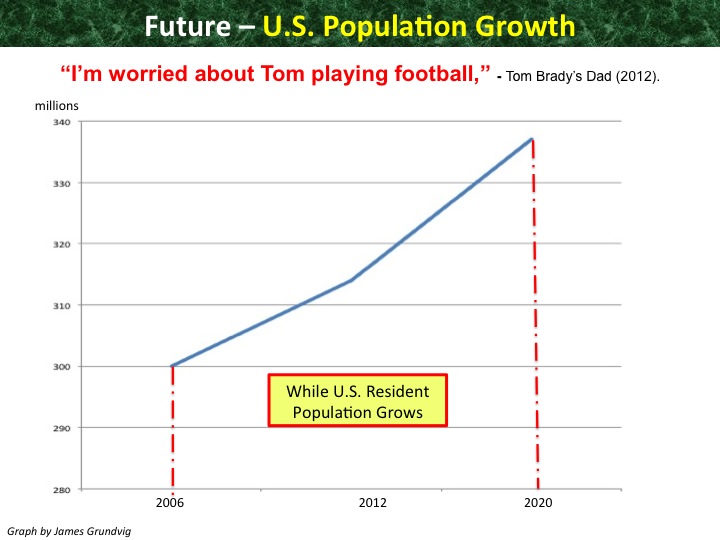That the NFL settled its class action lawsuit with 4,500 former NFL players, including ten Hall of Famers, wasn't surprising. Like other bad publicity irritants the NFL has tackled in the past, this one had to be sacked and buried before the regular season started, while many Americans are on vacation for the last week of summer.
The $765 million settlement from a lawsuit that would have been very damaging had it gone to trial and reached testimony phase is a small price for the league to pay, when amortized over the next 17 years. Factor in the NFL, which makes $9 billion in revenue each year with an ambitious goal to triple that pot of gold by 2027, and it will make the $38 million-a-year look like chump change by then.
For the players: Yes, there's another lawsuit that is pending against the NFL helmet maker in Riddell. The manufacturer of high school, college, and pro football helmets was not part of the settlement, and thus had no comment on this case.
The NFL was able to negotiate the paltry sum, which boils down to around $170,000 per player stretched out over two decades. That's a long time when many of those players will die, some will lose their cognitive abilities to function, and still others might commit suicide, as they have to make the suffering go away.
The league was also able to seal the entire discovery, written testimony, findings, and court documents, and thereby sweep away the bad publicity as if the crippling head injuries never existed.
The NFL got off cheap. They will pay the settlement as an annuity, thus drive down the actual costs, which won't be nearly as much as the total amount settled on paper.
On the flip side, the NFL has a serious issue on its hands. It won't go away with some share of revenue in licensing fees, Super Bowl hype marketing, cash disbursements, or feel-good publicity. The problem with football helmets and player concussions runs much deeper than any settlement money can buy. And it won't go away with the diagnostic R&D program the NFL launched separately last February -- well-timed again before the Super Bowl -- with G&E to the tune of $40 million over ten years.
Like data breaches by cyber hackers, awareness and training alone will never defeat human error in spear phishing attacks for malware and Trojan horses embedded in emails, their links, or file attachments. Statistics are not on the side of email training when the number of employees reaches in the thousands, with each receiving a couple hundred emails per day. Do the math. 100 percent effectiveness doesn't exist.
The same can be said of any diagnostic tool, whether those used today for early intervention to detect autism in babies. G&E tools might be able to detect subtle concussions in the future, but it won't save the pro players on the receiving end of traumatic concussions that force them into early retirement.
Young Player Attrition Will Hit the NFL Hard
This preseason, Kevin Kolb, a quarterback trying to fit in with his third team, had a major concussion that will likely end his career prematurely. On the play, he scrambled toward a first down with a few defensive players whiffing on tackling him; he hit the turf, rolled over, and appeared to hit his head in what looked like a typical play. He got up, finished the series, but then was done when the concussion took full effect on the sideline. His third major concussion will be his last in pro football.
What the NFL doesn't see -- or won't admit publicly -- and what no one in the media is talking about, is the coming tsunami that will, at bare minimum, deflate the quality of play in the NFL over the next two decades if nothing is done to reverse the trend on concussions.
Although it's not the NFL's problem alone, college football and high school football before it are starting to see the negative impact of the trend in attrition.

Since 2006, there are more than one million kids who no longer play the American game of football. During that time when I worked in the New York City construction industry, I met plenty of fathers who told me they would never allow their kids to play the sport, like we did when we were children. Times have changed. What's more shocking than the lost of 10 percent of the pool of kids no longer playing the game, is that the U.S. residential population is growing significantly over the same period.
So the negative gap between the fewer numbers of players playing football today than in 2006 is all the more jarring.

What will happen to American football if, in 20 years, more than half of the 9 million players who play today erodes in half or even lower? What will the quality of football be like? Will the sport, assimilating two-hand touch, be even watchable?
What are some of the solutions the NFL has come up with to the concussion epidemic? The Heads Up training and awareness program at the youth level and with the coaches, teaching the proper technique of tackling -- a lost art in the ESPN Sportscenter, look-at-me era of violent hits -- is one. Discussion of eliminating kickoffs is another.
If the latter occurs, this author will stop watching NFL football altogether. Why bother? Why watch it when the league rules out one of the most exciting plays in the game? I have been a fan of the NFL since I was four years old. Change the game that much I won't care. Why should I if I no longer recognize the game?
Besides, quarterback Kevin Kolb, former New York Jets receiver Al Toon, and several other players never entered the game on kickoffs. All of their careers were cut short on non-kickoff plays. If that were the case, what would the NFL be solving by chasing away loyal fans by over-regulating the game?
The real problem with the NFL has been its success. The league is trying to find a solution in every conceivable place except overhauling the design of the helmet. They need to take the blinders off, stop patting themselves on the back for minimizing the lawsuit by settling, and find a damn solution.
If the NFL invested $100 million in pure R&D on re-making, re-thinking, and re-designing the helmet, they would greatly reduce the concussion issue by a large factor by 2020. But do they want to radically change the helmet design that has been in place for the past half century?
The Problem with Today's Football Helmets
What few, if anyone, are talking about is the size and weight of football helmets to what they used to be in the 1960s, '70s, and on through the years to 2013.
It's more than the design of the bell-shaped, dome helmet that is ubiquitous and similar by all of the helmet manufacturers. It's the weight, stupid. Helmets are too heavy. And when lowered it becomes a lethal battering ram. And with players today much bigger and faster than their counterparts from 40 years ago, the heavier and stronger helmets have become a weapon of mass destruction.
Helmet manufacturers from Riddell and Schutt to Xenith and now Under Armour make the hard shells of the helmets all the same way: Slight changes in design, holes, and fit, with the only bigger differentiator being the inner lining and foam pads and cushions.
What has struck me as wrong with the NFL and all of the manufacturers' approach to helmet making is the evolutionary dead end of their modern design.
With my background on engineering-construction projects, why hasn't anyone thought of helmet design in terms of a physics equation? If there is one equation that captures the essence of football it is the momentum equation:
P = M x V
Momentum (P) = Mass (M) times Velocity (V) of the object.
If the helmet manufacturers began to look at this design, they would discover a couple of simple insights. First, the interior bladder of the helmet would have to behave differently than they do today. No longer would the interior bladder absorb shock, but transfer it in a ring around the helmet, and not directly against the skull. Second, the shell would have to be put on a serious diet with respect to weight and thickness and behavior, as well.
The shell of the helmet would have to act more like highway impact attenuators. They are the exit ramp buffers, the configured yellow barrels aligned like bowling pins that are filled with sand--not water as Hollywood wrongly depicts in car chase scenes. The impact barrels take a massive blow, crumple into one another, distributing the energy waves away from the point of the crash.
Transfer, Not Absorption, Is Needed in Helmet Design
The same transfer of energy would be needed to work on a lighter, crumpling helmet (not rigid) shell, to redirect the waves away from the crown of the head and distribute it around the contours of the helmet, which would have seams.
Greatly lower the G-force of such blows, would greatly lower the number of concussions of all kinds.
So perhaps the helmet makers should meet with highway engineers to come up with a radical new design. [Disclosure: I worked as a road and bridge inspector on many heavy highway projects in the past.]
The way it's being done today with incremental improvements to helmet design, with the sameness and heavy shell, with failed absorption materials, and not energy transfer design will guarantee more concussions to come. When that happens, lawyers won't be able to prevent the demise of American football with fewer and fewer kids playing the sport.
We live in a free society. And we the people, the parents, the guardians are free to choose for kids not to play the collision sport.
If nothing is done to fix the problem where it occurs, in the design of the helmet, then the NFL might devolve into a game few will recognize, watch, and play in the future.
If that happens, don't tell me they weren't warned.